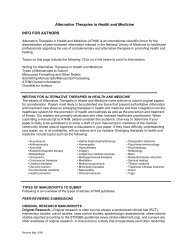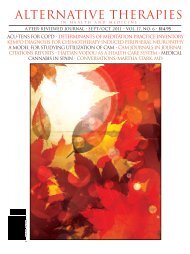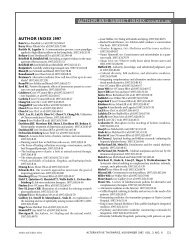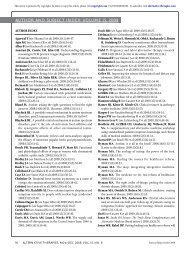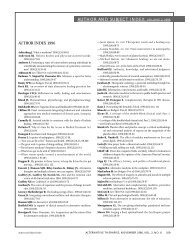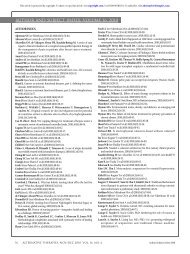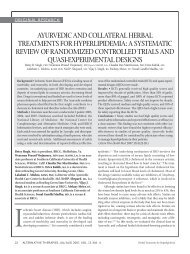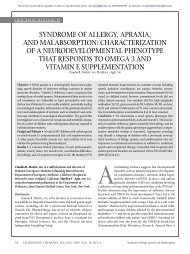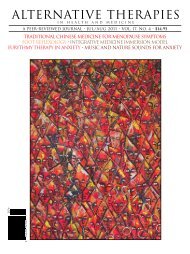Alternative Therapies In Health And Medicine
Alternative Therapies In Health And Medicine
Alternative Therapies In Health And Medicine
Create successful ePaper yourself
Turn your PDF publications into a flip-book with our unique Google optimized e-Paper software.
efore and after surgery. 4,5 During recovery after surgery, patients<br />
may feel helpless and be concerned about loss of control, physical<br />
discomfort, and doubts about their progress. 2,6 <strong>In</strong> addition, unfamiliar<br />
environments and sounds can create physiologic complications<br />
and delay recovery. 7,8<br />
Along with having anxiety, patients experience pain after cardiac<br />
surgery. This type of postoperative pain has no functional value<br />
beyond signaling the presence of tissue damage from surgery, and it<br />
may actually have harmful psychologic and physiologic consequences.<br />
As the stress response increases, wound healing may be<br />
impaired. 8,9 Pain also interferes with the patient’s sleep and appetite<br />
and can create anxiety, compounding complications with other components<br />
of the cardiovascular system and gastrointestinal tract,<br />
thereby prolonging recovery. 10,11<br />
The Agency for <strong>Health</strong>care Research and Quality recommendations<br />
for pain management include the use of cognitivebehavioral<br />
interventions such as relaxation, music, distraction,<br />
and imagery. 12 These interventions have been shown to reduce<br />
the amount of pain medication used and to improve the management<br />
of pain and anxiety. 13,14<br />
Music is well known as a positive integrative therapy with<br />
its therapeutic qualities of enhancing well-being, reducing anxiety<br />
and stress, and distracting people from unpleasant painful<br />
stimuli. 13,15-19 Ambient Therapy (Ambience Medical, Omaha,<br />
Nebraska) uses specifically designed music that combines natural<br />
sounds recorded in a 200 x 200–foot time-delay algorithm<br />
with musical parts created to enhance emotions. These specifically<br />
recorded sounds of nature are thought to minimize the<br />
patient’s perception of spikes or startle sounds in his or her environment.<br />
This effect is hypothesized to provide patients with a<br />
new perceptual reality so that the hospital environment is soothing<br />
and comforting, helping the patient counteract feelings of<br />
pain and anxiety. 20 Evidence shows that a convergence occurs<br />
between sensory input (such as ambient music) and neural output<br />
(through the central nervous system) that regulates pain and<br />
stress responses. 21<br />
The purpose of this study was to test the effects of structured<br />
music with nature sounds on the level of pain and anxiety in cardiac<br />
surgical patients.<br />
Methods<br />
Research Design<br />
A stratified randomized experimental design was used to assign<br />
patients to standard postoperative care in combination with ambient<br />
music sessions (the music group) or to standard postoperative<br />
care in combination with matched quiet resting sessions (the control<br />
group) (Figure 1). This protocol was reviewed and approved by the<br />
Mayo Clinic <strong>In</strong>stitutional Review Board.<br />
Research Setting<br />
The participants were cardiac surgical patients at Saint Marys<br />
Hospital in Rochester, Minnesota. Data were collected while the<br />
patients were in the cardiovascular surgical intensive care and progressive<br />
care units of the hospital.<br />
Enrollment<br />
Allocation<br />
Completion<br />
Analysis<br />
349 Patients assessed for eligibility<br />
173 Randomized<br />
87 Allocated to<br />
standard care and<br />
quiet resting sessions<br />
51 Completed<br />
the sessions<br />
51 <strong>In</strong>cluded<br />
in analysis<br />
176 Excluded<br />
55 Did not meet inclusion criteria<br />
89 Refused to participate<br />
32 Excluded for other reasons<br />
86 Allocated to<br />
standard care and<br />
ambient music sessions<br />
49 Completed<br />
the sessions<br />
49 <strong>In</strong>cluded<br />
in analysis<br />
FIGURE 1 Patient Flowchart. <strong>In</strong> this randomized controlled trial, cardiac<br />
surgical patients were randomly assigned to receive standard postoperative<br />
care with sessions of either quiet rest or ambient music.<br />
<strong>In</strong>clusion Criteria<br />
Participants were cardiac surgical patients, aged 18 years or<br />
older, who had undergone first-time CABG surgery or cardiac valve<br />
surgery (or both) and had consented to participate in the study.<br />
Exclusion Criteria<br />
Patients were excluded from the study if they were non–English<br />
speaking, if they were intubated on postoperative day 2, or if they<br />
had a diagnosis of chronic pain, a chronic psychiatric disorder, or a<br />
hearing impairment that would interfere with hearing the music.<br />
Randomization<br />
At the start of postoperative day 2, patient pain levels were<br />
assessed on a scale from 0 (no pain) to 10 (the most intense pain),<br />
and stratification for randomization was based on a pain level of 4 or<br />
less (the institutional pain level goal) or greater than 4. The randomization<br />
was blocked to ensure balanced allocation throughout the<br />
course of the study. There were 25 randomized blocks of 4 patients<br />
and 25 randomized blocks of 2 patients. Each set of 50 blocks was<br />
changed into a random order as well. To account for potentially nonrandom<br />
dropouts, the randomization scheme was determined in<br />
advance for 150 patients per stratum, and enrollment was continued<br />
until at least 100 patients in total had completed day 4 of the study.<br />
The use of cards in sealed envelopes prevented the study coordinator<br />
Nature Sounds and Music After Cardiac Surgery<br />
ALTERNATIVE THERAPIES, jul/aug 2011, VOL. 17, NO. 4 17



